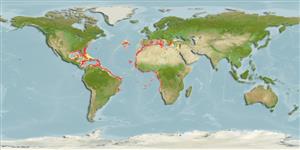Preferred temperature (Ref.
123201): 7.1 - 15.9, mean 12.6 °C (based on 338 cells).
Phylogenetic diversity index (Ref.
82804): PD
50 = 0.5000 [Uniqueness, from 0.5 = low to 2.0 = high].
Bayesian length-weight: a=0.00162 (0.00101 - 0.00260), b=3.05 (2.91 - 3.19), in cm total length, based on LWR estimates for this species & (Sub)family-body (Ref.
93245).
Trophic level (Ref.
69278): 3.4 ±0.0 se; based on diet studies.
Resilienza (Ref.
120179): Medio, tempo minimo di raddoppiamento della popolazione 1.4 - 4.4 anni (K=0.18; tmax=9).
Fishing Vulnerability (Ref.
59153): Low vulnerability (15 of 100).
Nutrients (Ref.
124155): Calcium = 61.2 [28.1, 133.5] mg/100g; Iron = 0.77 [0.40, 1.46] mg/100g; Protein = 16.7 [14.9, 18.5] %; Omega3 = 0.262 [0.122, 0.517] g/100g; Selenium = 49 [19, 110] μg/100g; VitaminA = 29.1 [7.2, 127.8] μg/100g; Zinc = 1.02 [0.66, 1.63] mg/100g (wet weight);
